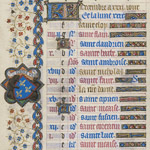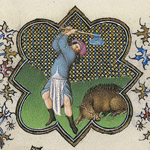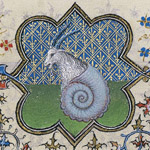 |
 |
 |
Above, from left to right: Calendar page for December from the Belles Heures of Jean de France, Duc de Berry, 1405???1408/1409. Pol, Jean, and Herman de Limbourg (Franco-Netherlandish, active in France, by 1399???1416). French; Made in Paris. The Metropolitan Museum of Art, New York, The Cloisters Collection, 1954 (54.1.1); detail of the activity for the month; detail of the zodiacal symbol Capricorn. See the Collection Database to learn more about this work of art.
A boar, wild or domesticated, is an uncastrated adult male pig. Swine were domesticated earlier than any animal other than the dog, and all domesticated hogs descend from a single wild species, Sus scrofa, although numerous subspecies are recognized and many breeds have been developed.
As befits an animal that has lived in such close conjunction with humans for so many centuries, pigs have acquired much religious and symbolic significance, both positive and negative, while cleaning up around the dooryard and greasing chins. (See “Pigs in Religion and Folklore” on Professor Joshua Bamfield’s website.) Many medieval calendar images for this month depict either the slaughter of the domestic boar or the hunting and killing of a wild one. (See the December page of the Tr??s Riches Heures.) Bridget Henisch observes that the death of the boar in December is the only death portrayed in the medieval calendar tradition.
Unlike sheep and cattle, domesticated swine were not kept over the winter, but were slaughtered to provide food for the cold season. Peasants are often shown either dispatching a hog with an ax or slitting its throat, preparatory to making the bacon, hams, and blood puddings that were an important part of their winter diet. The wild boar hunt of the Middle Ages, however, was an aristocratic activity that was an exercise in martial skill and a proof of valor. The famous hunting manual of Gaston Phoebus, Count of Foix, provides several illuminated chapters on the pursuit of this dangerous animal, including ???How to put the wild board to the sword.??? (See the online exhibition on the Morgan Library & Museum website.) Although boars were brought down by hounds, Gaston??remarks that the dogs??? fangs could not tear their tough hides, which could only be pierced by pikes or arrows. Once the boar turns to face his tormentors, the huntsman should??rise in his saddle and throw his pike like a javelin; he must then dismount and dispatch the dying boar with a sword thrust, carefully and from behind.
While the peasant???s Christmas dinner might consist of pork, the head of the wild boar, bedecked with bays and rosemary,??was at the front and center of the nobleman???s feast, as in the famous fifteenth-century Boar’s Head carol still sung today. Le Viandier, a recipe collection compiled about the year 1300, describes a rich dish called bourbelier, for which a wild boar is boiled and then roasted and basted with a sauce of ginger, cinnamon, cloves, and grains of paradise.
???Deirdre Larkin
Sources:
Gaston III Phoebus. The Hunting Book of Gaston Ph??bus. Preface by Christian de Longevialle; introduction and captions by Clause d???Anthenaise; translated Ian Monk. Dallas,TX: Hackberry Press, 2002.
Henisch, Ann Bridget. The Medieval Calendar Year. University Park, PA: The Pennsylvania State University Press, 1999.
Husband, Timothy B. The Art of Illumination. New York: The Metropolitan Museum of Art, 2008.
Redon, Odile, Francoise Sabban & Silvano Serventi. The Medieval Kitchen: Recipes from France and Italy. Translated by Edward Schneider. Chicago: The University of Chicago Press, 1998.
